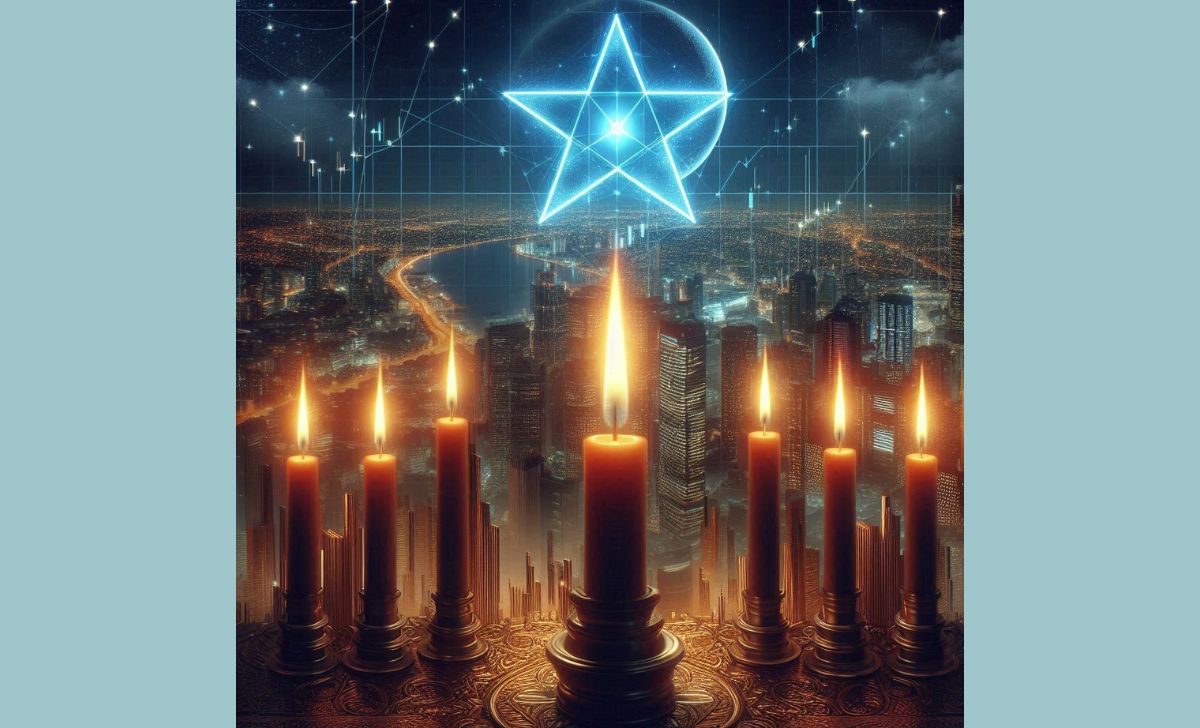Evening Star Pattern is a well-known candlestick formation that signals a potential bearish reversal in the market. It's one of the most effective candlestick signals used by technical analysts to detect trend reversals.
By understanding its structure and integrating it with broader technical and strategic frameworks, traders can make more informed decisions and improve their chances of success. This article will explain the structure of the Evening Star Pattern, compare it to the Morning Star, and show how you can apply it flexibly in your own strategies.

What is the Evening Star Pattern?
The Evening Star Pattern is a three-candle formation that appears at the top of an uptrend. It is typically composed of:
- A large bullish (green) candle indicating continued upward momentum.
- A small-bodied candle (which can be bullish or bearish) showing indecision in the market. This candle often gaps up from the previous one.
- A large bearish (red) candle that closes well into the body of the first candle, confirming the reversal.
The appearance of this pattern indicates that buyers are losing control, and sellers are beginning to dominate, potentially marking the beginning of a downtrend.
Evening Star Pattern vs. Morning Star Pattern
To better understand the significance of the Evening Star Pattern, it's helpful to compare it with its bullish counterpart—the Morning Star Pattern. Both patterns consist of three candles and are used to identify potential market reversals, but they signal opposite directions and appear in different market contexts.

The Evening Star Pattern typically forms at the top of an uptrend and serves as a bearish reversal signal. It begins with a large bullish (green) candle, reflecting strong upward momentum. The second candle is small-bodied, indicating market indecision, and it often gaps up slightly from the first. Finally, the third candle is a large bearish (red) candle that closes deep into the body of the first, confirming a shift from buyer dominance to selling pressure.
In contrast, the Morning Star Pattern appears at the bottom of a downtrend and signals a potential bullish reversal. It starts with a large bearish (red) candle that demonstrates downward momentum. The second candle, similar to the Evening Star, is small-bodied and represents indecision, often showing a slight gap down. The third candle is a strong bullish (green) candle that closes well into the body of the first, indicating renewed buying strength.
Explore more: Evening star candlestick pattern: A Simple 3-Step Guide to Analyzing the Pattern
In summary, while both patterns share a similar structure—three candles with a transition of momentum in the middle—the Evening Star Pattern indicates a shift from bullish to bearish sentiment, while the Morning Star Pattern suggests the opposite: a turn from bearish to bullish. Understanding these patterns in context can provide traders with timely entry and exit points, especially when confirmed by other technical indicators.

Flexible Applications of the Evening Star Pattern
The Evening Star Pattern can be effectively applied across different financial markets, including stocks, forex, commodities, and cryptocurrencies. Its flexibility makes it a valuable tool in any trader’s arsenal. Here are some of its key applications:
Confirmation with Technical Indicators
Although the pattern itself can be a strong signal, combining it with other indicators like the Relative Strength Index (RSI), Moving Averages, or MACD can provide stronger confirmation. For example, an Evening Star Pattern appearing when the RSI is in overbought territory gives traders more confidence in the bearish reversal.
Multi-Timeframe Analysis
Traders often use the Evening Star Pattern in conjunction with multiple timeframes to enhance accuracy. A pattern that appears on a higher timeframe, such as the daily or weekly chart, carries more weight and reliability compared to one on a shorter timeframe.

Risk Management and Entry Strategies
When identifying an Evening Star Pattern, traders typically wait for the completion of the third candle before entering a short position. Stop-loss orders are commonly placed just above the high of the pattern to manage risk effectively. Additionally, using support and resistance levels can help in determining target prices.
Algorithmic and Quantitative Trading
In modern trading systems, candlestick patterns like the Evening Star Pattern are often coded into algorithms to trigger automatic buy or sell decisions. When combined with volume data and volatility measures, these algorithms can enhance trading efficiency and reduce emotional bias.
The Evening Star Pattern is a classic yet powerful bearish reversal signal. When compared with the Morning Star, it offers traders a balanced view of market psychology at critical turning points. Whether you're a beginner or an experienced trader, mastering the Evening Star Pattern can add a significant edge to your technical analysis toolkit.
Explore more: Evening Star: How to Distinguish Between Real and False Signals